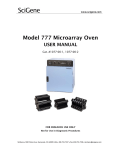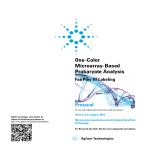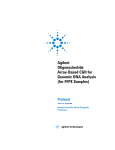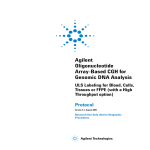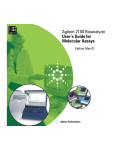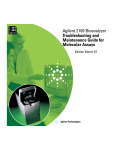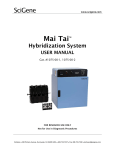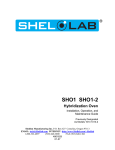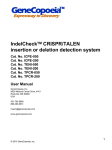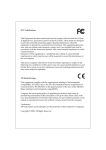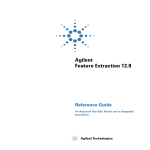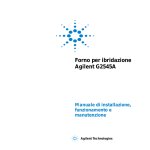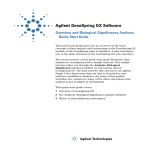Download miRNA Microarray System with miRNA Complete Labeling and Hyb Kit
Transcript
miRNA Microarray System with miRNA Complete Labeling and Hyb Kit Protocol For use with Agilent miRNA microarrays Version 2.0, June 2008 Microarrays manufactured with Agilent SurePrint Technology Research Use Only. Not for use in Diagnostic Procedures. Agilent Technologies Notices © Agilent Technologies, Inc. 2008 Warranty No part of this manual may be reproduced in any form or by any means (including electronic storage and retrieval or translation into a foreign language) without prior agreement and written consent from Agilent Technologies, Inc. as governed by United States and international copyright laws. The material contained in this document is provided “as is,” and is subject to being changed, without notice, in future editions. Further, to the maximum extent permitted by applicable law, Agilent disclaims all warranties, either express or implied, with regard to this manual and any information contained herein, including but not limited to the implied warranties of merchantability and fitness for a particular purpose. Agilent shall not be liable for errors or for incidental or consequential damages in connection with the furnishing, use, or performance of this document or of any information contained herein. Should Agilent and the user have a separate written agreement with warranty terms covering the material in this document that conflict with these terms, the warranty terms in the separate agreement shall control. Manual Part Number G4170-90011 Edition Version 2.0, June 2008 Printed in USA Agilent Technologies, Inc. 5301 Stevens Creek Rd Santa Clara, CA 95051 USA Acknowledgements ® ® Adobe and Acrobat are registered trademarks of Adobe Systems Incorporated. Pentium® is a U.S. registered trademark of Intel Corporation. Windows® is a registered trademark of Microsoft Corporation in the U.S. Technical Support For technical product support, contact your local Agilent Support Services representative. You can get Agilent’s worldwide sales and support center telephone numbers at: www.agilent.com/chem/contactus or send an email to: [email protected] Limited Use License for End Users For Internal Research Use only. Not for use in diagnostic procedures. See “Limited Use License for End Users - Nucleotide Analog Component" on page 48 for more licensing information. 2 Technology Licenses The hardware and/or software described in this document are furnished under a license and may be used or copied only in accordance with the terms of such license. Restricted Rights Legend Safety Notices CAUTION A CAUTION notice denotes a hazard. It calls attention to an operating procedure, practice, or the like that, if not correctly performed or adhered to, could result in damage to the product or loss of important data. Do not proceed beyond a CAUTION notice until the indicated conditions are fully understood and met. WA R N I N G A WARNING notice denotes a hazard. It calls attention to an operating procedure, practice, or the like that, if not correctly performed or adhered to, could result in personal injury or death. Do not proceed beyond a WARNING notice until the indicated conditions are fully understood and met. U.S. Government Restricted Rights. Software and technical data rights granted to the federal government include only those rights customarily provided to end user customers. Agilent provides this customary commercial license in Software and technical data pursuant to FAR 12.211 (Technical Data) and 12.212 (Computer Software) and, for the Department of Defense, DFARS 252.227-7015 (Technical Data - Commercial Items) and DFARS 227.7202-3 (Rights in Commercial Computer Software or Computer Software Documentation). miRNA Microarray System with miRNA Complete Labeling and Hyb Kit Protocol In this Guide... This document describes Agilent’s recommended procedures for the preparation and labeling of complex biological targets and hybridization, washing, scanning, and feature extraction of Agilent oligonucleotide microarrays for microarray-based miRNA systems. If you have comments about this protocol, send an e-mail to [email protected]. 1 Before You Begin This chapter contains information (such as procedural notes, safety information, required reagents and equipment, as well as total RNA extraction recommendations) that you should read and understand before you start an experiment. 2 Procedures This chapter describes the steps to prepare samples, hybridize, wash and scan miRNA microarrays, and to extract data using the Agilent Feature Extraction Software. 3 Characterization of Total RNA This chapter contains instructions for characterization of total RNA. 4 Reference This chapter contains reference information related to the protocol and the limited use license. miRNA Microarray System with miRNA Complete Labeling and Hyb Kit Protocol 3 What’s new in this version? This protocol is based on the miRNA Microarray System Protocol 1.5, with these differences: • Agilent miRNA Complete Labeling and Hyb Kit (p/n 5190-0456), which offers all the necessary reagents for labeling of samples and hybridization on the miRNA microarrays. • New labeling protocol with reduced reaction volumes. • Removal of the Spin Column Clean-up step. 4 miRNA Microarray System with miRNA Complete Labeling and Hyb Kit Protocol Contents 1 Before You Begin 7 Procedural Notes 8 Safety notes 8 Agilent Oligo Microarray Kit Contents 9 Required Equipment 9 Required reagents 11 Optional equipment/reagents 11 Required software and hardware 12 RNA extraction recommendation 13 2 Procedures 15 Sample Labeling and Hybridization 17 Step 1. Prepare the labeling reaction 18 Step 2. Prepare the 10X Blocking Agent 21 Step 3. Prepare hybridization samples 22 Step 4. Prepare the hybridization assembly 23 Microarray Wash 25 Step 1. Add Triton X-102 to Gene Expression wash buffers Step 2. Prewarm Gene Expression Wash Buffer 2 25 Step 3. Prepare the equipment 26 Step 4. Wash the microarray slides 27 25 Scanning and Feature Extraction 30 Step 1. Scan the slides 30 Step 2. Extract data using Agilent Feature Extraction Software 3 Characterization of Total RNA 32 37 Step 1. Prepare for characterization of total RNA miRNA Microarray System with miRNA Complete Labeling and Hyb Kit Protocol 39 5 Contents Step 2. Characterize the RNA samples using the Agilent 2100 Bioanalyzer 4 Reference 43 Supplemental User Guides 44 Microarray Handling Tips 45 General Microarray Layout and Orientation 46 Array/Sample tracking on a 8x15K array slide 47 Limited Use License for End Users - Nucleotide Analog Component 6 40 48 miRNA Microarray System with miRNA Complete Labeling and Hyb Kit Protocol miRNA Microarray System with miRNA Complete Labeling and Hyb Kit Protocol 1 Before You Begin Procedural Notes 8 Safety notes 8 Agilent Oligo Microarray Kit Contents 9 Required Equipment 9 Required reagents 11 Optional equipment/reagents 11 Required software and hardware 12 RNA extraction recommendation 13 Make sure you read and understand the information in this chapter and have the necessary equipment and reagents listed before you start an experiment. NOTE Agilent cannot guarantee microarray performance and does not provide technical support to those who use non-Agilent protocols in processing Agilent's microarrays. Agilent Technologies 7 1 Before You Begin Procedural Notes Procedural Notes • Determine the integrity of the input RNA for labeling and hybridization prior to use to increase the likelihood of a successful experiment. • To prevent contamination of reagents by nucleases, always wear powder-free laboratory gloves, and use dedicated solutions and pipettors with nuclease-free aerosol-resistant tips. • Maintain a clean work area. • When preparing frozen reagent stock solutions for use: 1 Thaw the aliquot as rapidly as possible without heating above room temperature. 2 Mix briefly on a vortex mixer, then spin in a centrifuge for 5 to 10 seconds to drive the contents off of walls and lid. 3 Store on ice or in a cold block until use. • In general, follow Biosafety Level 1 (BL1) safety rules. Safety notes WA R N I N G • Dimethyl Sulfoxide (DMSO) may be harmful by inhalation, ingestion or skin absorption. DMSO vapor or mist is irritating to the eyes, mucous membranes and upper respiratory tract. It can cause skin irritation and allergic respiratory and skin reactions. Overexposure may cause reproductive disorder(s) based on tests with laboratory animals. • 2X Hi-RPM Hybridization Buffer is considered hazardous by the OSHA Hazard Communication Standard (29 CFR 1910.1200). It may be harmful if swallowed. The buffer contains material that may cause damage to the skin and central nervous system. Please refer to the MSDS for complete safety information. 8 miRNA Microarray System with miRNA Complete Labeling and Hyb Kit Protocol Before You Begin Agilent Oligo Microarray Kit Contents 1 Agilent Oligo Microarray Kit Contents • Eight microarrays printed on a 1-inch × 3-inch glass slide; three slides per kit. • CD containing microarray design files in various file formats. Table 1 shows the Product Name and the associated Product Number for the kits available. Each kit has an associated Design ID, the latest version of which can be obtained on-line at www.agilent.com/chem/miRNA. Click miRNA Microarray under Platform Products. Table 1 NOTE Product Name Content Format Product Number Human miRNA Microarray 3 slides, 8 microarrays/slide 8 x 15K Agilent p/n G4470A Human miRNA Microarray (V2) 3 slides, 8 microarrays/slide 8 x 15K Agilent p/n G4470B Mouse miRNA Microarray 3 slides, 8 microarrays/slide 8 x 15K Agilent p/n G4472A Rat miRNA Microarray 3 slides, 8 microarrays/slide 8 x 15K Agilent p/n G4473A Store entire kit at room temperature. After breaking foil on microarray pouch, store microarray slides at room temperature (in the dark) under a vacuum dessicator or N2 purge box. Do not store microarray slides in open air after breaking foil. Required Equipment Table 2 Required equipment Description Company and part no. Microarray Scanner Agilent p/n G2565BA Hybridization Chamber, stainless Agilent p/n G2534A Hybridization Chamber gasket slides 8 microarrays/slide, 5 slides/box Agilent p/n G2534-60014 Hybridization oven 20 rpm capability; temperature set at 55°C Agilent p/n G2545A miRNA Microarray System with miRNA Complete Labeling and Hyb Kit Protocol 9 1 Before You Begin Required Equipment Table 2 Required equipment (continued) Description (continued) Company and part no. Hybridization oven rotator for Agilent Microarray Hybridization Chambers Agilent p/n G2530-60029 Nuclease-free 1.5 mL microcentrifuge tubes Eppendorf p/n 022363204 or equivalent Magnetic stir bar (×2) Corning p/n 401435 or equivalent Magnetic stir plate Corning p/n 6795-410 or equivalent Magnetic stir plate with heating element Microcentrifuge Eppendorf p/n 5417R or equivalent Slide-staining dish, with slide rack (×3) Thermo Shandon p/n 121 or equivalent Circulating water baths or heat blocks set to 16°C, 37°C, and 100°C. Corning p/n 6795-420 or equivalent Vacuum concentrator with heater Savant SpeedVac p/n SPD111V or equivalent 1.5L glass dish Pyrex p/n 7211 or equivalent Clean forceps Ice bucket Pipetman micropipettors, (P-10, P-20, P-200, P-1000) or equivalent Powder-free gloves Sterile, nuclease-free aerosol barrier pipette tips Vortex mixer Timer N2 purge box for slide storage 10 miRNA Microarray System with miRNA Complete Labeling and Hyb Kit Protocol Before You Begin Required reagents 1 Required reagents Table 3 Description Company and part no. miRNA Complete Labeling and Hyb Kit Agilent p/n 5190-0456 Gene Expression Wash Buffer Kit Agilent p/n 5188-5327 Milli-Q water or equivalent Optional equipment/reagents Table 4 Description Company and part no. 2100 Bioanalyzer Agilent p/n G2938A RNA 6000 Nano Kit Agilent p/n 5067-1511 RNA 6000 Pico Kit Agilent p/n 5067-1513 Small RNA Kit Agilent p/n 5067-1548 Slide box Corning p/n 07201629 PCR 96 plate Eppendorf p/n 951020401or equivalent Thermocycler miRNA Microarray System with miRNA Complete Labeling and Hyb Kit Protocol 11 1 Before You Begin Required software and hardware Required software and hardware Table 5 Description Agilent G4450AA Feature Extraction software 9.5 or later Agilent Scan Control software, version A. 7.0 or later (includes XDR functionality) Pentium IV 1.5 GHz or higher 512 MB RAM (1 GB recommended) 20 GB available disk space (if saving images and results files locally) Microsoft Windows 2000 with SP2 or later (fully tested on SP4), Windows XP SP2 Microsoft Internet Explorer 5.5 or later Adobe Acrobat Reader 4.0 or later Agilent GeneSpring software GX9.0 or later (optional) 12 miRNA Microarray System with miRNA Complete Labeling and Hyb Kit Protocol Before You Begin RNA extraction recommendation 1 RNA extraction recommendation Total RNA extraction methods differ in numerous ways and may impact: • yield • the inclusion of small RNAs in the total RNA extraction • the quantification of the total RNA These extraction methods have worked successfully with Agilent’s miRNA Microarray System: • miRNeasy Mini Kit - Qiagen p/n 217004 • mirVana RNA Isolation Kit - Applied Biosystem p/n AM1560 • TRIZOL Reagent (100 mL) - Invitrogen p/n 15596-026 When you use these or any other commercial kit, use the total RNA isolation protocol. Do not use the size fractionation or small RNA enrichment protocol. You must use the same total RNA extraction methods to obtain consistent results for comparative experiments. Different total RNA extraction methods may result in slightly different miRNA profiles. Extraction methods that use organic solvents such as TRIZOL may result in inaccurate quantification, because organic solvent contamination from carry-over during the RNA extraction may compress the 260/230 ratio. The affected 260 measurement may result in inaccurate quantification of the total RNA. If you want to ensure the removal of residual TRIZOL reagent, do one to two additional chloroform extractions after the final extraction step in the TRIZOL protocol, before you continue to the ethanol precipitation. See “Characterization of Total RNA” on page 37 for more information on RNA purity and quality assessment. miRNA Microarray System with miRNA Complete Labeling and Hyb Kit Protocol 13 1 14 Before You Begin RNA extraction recommendation miRNA Microarray System with miRNA Complete Labeling and Hyb Kit Protocol miRNA Microarray System with miRNA Complete Labeling and Hyb Kit Protocol 2 Procedures Sample Labeling and Hybridization 17 Step 1. Prepare the labeling reaction 18 Step 2. Prepare the 10X Blocking Agent 21 Step 3. Prepare hybridization samples 22 Step 4. Prepare the hybridization assembly 23 Microarray Wash 25 Step 1. Add Triton X-102 to Gene Expression wash buffers 25 Step 2. Prewarm Gene Expression Wash Buffer 2 25 Step 3. Prepare the equipment 26 Step 4. Wash the microarray slides 27 Scanning and Feature Extraction 30 Step 1. Scan the slides 30 Step 2. Extract data using Agilent Feature Extraction Software 32 Agilent’s miRNA Microarray System uses cyanine 3-labeled targets to measure miRNA in experimental and control samples. Figure 1 is a standard workflow for sample preparation and array hybridization. Agilent Technologies 15 2 Procedures Total RNA (100ng)* Phosphatase Treatment, incubate 30 minutes, 37°C Dephosphorylated RNA* Add DMSO Heat, Ice Assemble Labeling Reaction, incubate 2 hours, 16°C Labeled RNA* Dry sample with vacuum concentrator, 1 to 2 hours, 45°C to 55°C Assemble Hybridization Mixture Heat, Ice Hybridize 20 hours, 55°C, 20 RPM Wash, Scan miRNA Profile *The sample can be stored frozen at -80°C if needed. Figure 1 16 Workflow for sample preparation and array processing. The sample can be frozen after drying and before hybridization mixture assembly. miRNA Microarray System with miRNA Complete Labeling and Hyb Kit Protocol Procedures Sample Labeling and Hybridization 2 Sample Labeling and Hybridization Agilent’s miRNA Complete Labeling and Hyb Kit (p/n 5190-0456) generates fluorescent miRNA with a sample input of 100ng of total RNA. This method involves the ligation of one Cyanine 3-pCp molecule to the 3' end of a RNA molecule with greater than 90% efficiency. The Agilent miRNA Complete Labeling and Hyb Kit provides all the needed components for sample labeling and hybridization preparation. This includes: • Calf Intestinal Alkaline Phosphatase (CIP) • 10X Calf Intestinal Phosphatase Buffer • T4 RNA Ligase • 10X T4 RNA Ligase Buffer • Dimethyl sulfoxide (DMSO) • Nuclease-Free Water • Cyanine 3-pCp • 10X GE Blocking Agent • 2X Hi-RPM Hybridization Buffer NOTE Please refer to “Characterization of Total RNA” on page 37 for procedural recommendations on total RNA characterization. miRNA Microarray System with miRNA Complete Labeling and Hyb Kit Protocol 17 2 Procedures Step 1. Prepare the labeling reaction Step 1. Prepare the labeling reaction Dephosphorylation 1 Dilute total RNA sample to 50 ng/µL in 1x TE pH 7.5 or DNase/RNase-free water. 2 Add 2 µL (100ng) of the diluted total RNA to a 1.5 mL microcentrifuge tube and maintain on ice. 3 Immediately prior to use, gently mix the components listed in Table 6 to prepare for the Calf Intestinal Alkaline Phosphatase (CIP) Master Mix by adding in the order indicated, and maintain on ice. Table 6 CIP Master Mix Components Volume (µL) per reaction Volume (µL) per 9 reactions 10X Calf Intestinal Phosphatase Buffer 0.4 3.6 Nuclease-Free Water 1.1 9.9 Calf Intestinal Phosphatase 0.5 4.5 Total Volume 2.0 18.0 4 Add 2 µL of the CIP Master Mix to each sample tube for a total reaction volume of 4 µL. Gently mix by pipetting. 5 Dephosphorylate the sample by incubating the reaction at 37°C in a circulating water bath or heat block for 30 minutes. If needed, the samples can be stored at -80°C after incubation. NOTE 18 A thermocycler, in conjunction with PCR plates, can be used to process a large number of samples. Use a PCR cap to seal the plates. Do not use tape. miRNA Microarray System with miRNA Complete Labeling and Hyb Kit Protocol Procedures Step 1. Prepare the labeling reaction 2 Denaturation 1 Add 2.8 µL of 100% DMSO to each sample. 2 Incubate samples at 100°C in a circulating water bath or heat block for 5 to 10 minutes. CAUTION Incubate the sample for no less than 5 minutes and no more than 10 minutes, or the labeling efficiency of the sample will be affected. 3 Immediately transfer to ice-water bath. CAUTION You must use an ice-water bath and not just crushed ice to ensure that the samples remain properly denatured. When using a thermocycler, transfer the PCR plate to an ice-water bath immediately after incubating at 100°C to prevent the RNA from re-annealing. Thermocyclers do not cool as quickly as is needed. 4 Continue to the next step immediately. miRNA Microarray System with miRNA Complete Labeling and Hyb Kit Protocol 19 2 Procedures Step 1. Prepare the labeling reaction Ligation 1 Warm the 10X T4 RNA Ligase Buffer at 37°C and vortex until all precipitate is dissolved. CAUTION Make sure that the 10X T4 RNA Ligase Buffer has cooled to room temperature before you proceed. Failure to do so will affect the T4 RNA Ligase activity, and thus the labeling efficiency. 2 Immediately prior to use, prepare the Ligation Master Mix by gently mixing the components listed in Table 7 and maintain on ice. Table 7 CAUTION Ligation Master Mix for T4 RNA Ligase Components Volume (µL) per reaction Volume (µL) per 9 reactions 10X T4 RNA Ligase Buffer 1.0 9.0 Cyanine3-pCp 3.0 27.0 T4 RNA Ligase 0.5 4.5 Total Volume 4.5 40.5 Be sure to use the Ligation Master Mix within 15 minutes of mixing all the components in Table 7. Failure to do so may affect the labeling efficiency. 3 Immediately add 4.5 µL of the Ligation Master Mix to each sample tube for a total reaction volume of 11.3 µL. 4 Gently mix by pipetting and gently spin down. 5 Incubate at 16°C in a circulating water bath or cool block for 2 hours. 6 After the 16°C labeling reaction, completely dry the samples. Use a vacuum concentrator at 45 to 55°C or on the medium-high heat setting. This step may take up to 2 hours. No clean up step is required. 20 miRNA Microarray System with miRNA Complete Labeling and Hyb Kit Protocol Procedures Step 2. Prepare the 10X Blocking Agent CAUTION 2 The sample must be completely dried after labeling. The presence of DMSO can cause drying to take up to two hours. Residual DMSO will adversely affect the hybridization results. Step 2. Prepare the 10X Blocking Agent 1 Add 125 µL of nuclease-free water to the vial containing lyophilized 10X GE Blocking Agent supplied with the Agilent miRNA Complete Labeling and Hyb Kit (p/n 5190-0456). 2 Mix by gently vortexing. If the pellet does not go into solution completely, heat the mix for 4 to 5 minutes at 37°C. 3 Drive down any material adhering to the tube walls or cap by centrifuging for 5 to 10 seconds at 17,000 x g. NOTE 10X Blocking Agent can be prepared in advance and stored at -20°C for up to 2 months. After thawing, repeat the vortexing and centrifugation procedures before use. miRNA Microarray System with miRNA Complete Labeling and Hyb Kit Protocol 21 2 Procedures Step 3. Prepare hybridization samples Step 3. Prepare hybridization samples 1 Equilibrate water bath or heat block to 100°C. 2 Resuspend the dried sample in 18 µL of nuclease-free water. 3 Add 4.5 µL of the 10X GE Blocking Agent to each sample. 4 Add 22.5 µL of 2x Hi-RPM Hybridization Buffer to each sample for a total of 45 µL. 5 Mix well but gently on a vortex mixer. Table 8 Hybridization mix for miRNA microarrays Components Volume (µL) Labeled miRNA sample 18 10X GE Blocking Agent 4.5 2X Hi-RPM Hybridization Buffer 22.5 Total Volume 45 For best results, stagger the tubes in sets of eight such that eight arrays on one array slide can be loaded at once. Have the SureHyb chamber along with the gaskets and microarrays easily available to prepare the hybridization assembly before you continue to the next step. 6 Incubate at 100°C for 5 minutes. 7 Immediately transfer to an ice water bath for 5 minutes. CAUTION Do not leave samples in the ice water bath for more than 15 minutes. Longer incubations may adversely affect the hybridization results. 8 Quickly spin in a centrifuge to collect any condensation at the bottom of the tube. 9 Immediately proceed to “Step 4. Prepare the hybridization assembly” on page 23. 22 miRNA Microarray System with miRNA Complete Labeling and Hyb Kit Protocol Procedures Step 4. Prepare the hybridization assembly 2 Step 4. Prepare the hybridization assembly Refer to the Agilent Microarray Hybridization Chamber User Guide (G2534-90001) for in-depth instructions on how to load slides, assembly and disassembly of chambers, as well as other helpful tips. This user guide is available with the Agilent Microarray Hybridization Chamber Kit (G2534A) and can also be downloaded from the Agilent Web site at www.agilent.com/chem/dnamanuals-protocols. To process the miRNA system microarray: 1 Load a clean gasket slide into the Agilent SureHyb chamber base with the label facing up and aligned with the rectangular section of the chamber base. Ensure that the gasket slide is flush with the chamber base and is not ajar. NOTE If you are not processing all of the arrays on a slide, place unused gasket wells at the far end opposite the barcode. In the unused wells, pipette 45 µL of 1x hybridization buffer. 2 Slowly dispense all of the volume of the hybridization sample onto the gasket well in a “drag and dispense” manner. Heating and cooling the hybridization sample results in varying degrees of volume loss. To adjust for the variation in final sample volume, adjust your pipette to avoid the introduction of air bubbles during application to the gasket well. To avoid leakage from the gasket well, minimize the introduction of bubbles during sample loading. CAUTION Do not allow the pipette tip or the hybridization solution to touch the gasket walls. Allowing liquid to touch the gasket wall greatly increases the likelihood of gasket leakage. 3 Slowly place an array “active side” down onto the SureHyb gasket slide, so that the “Agilent”-labeled barcode is facing down and the numeric barcode is facing up. Verify that the sandwich-pair is properly aligned. CAUTION When you assemble the array slide to the gasket slide, keep the array slide parallel to the gasket slide at all times, and do not drop the array slide onto the gasket slide. Doing so increases the chances of samples mixing between gasket wells. miRNA Microarray System with miRNA Complete Labeling and Hyb Kit Protocol 23 2 Procedures Step 4. Prepare the hybridization assembly 4 Place the SureHyb chamber cover onto the sandwiched slides and slide the clamp assembly onto both pieces. 5 Hand-tighten the clamp onto the chamber. 6 Vertically rotate the assembled chamber to wet the gasket and assess the mobility of the bubbles. If necessary, tap the assembly on a hard surface to move stationary bubbles. 7 Place assembled slide chamber in rotisserie in a hybridization oven set to 55°C. Set your hybridization rotator to rotate at 20 rpm. 8 Hybridize at 55°C for 20 hours. CAUTION Be sure that the arrays are hybridized for at least 20 hours. Hybridization can occur for longer than 20 hours but the actual hybridization time should be consistent if the results are to be compared. Failure to maintain consistent hybridization times may adversely affect your data. CAUTION If you are not loading all the available positions on the hybridization rotator rack, be sure to balance the loaded hybridization chambers on the rack so that there are an equal number of empty positions on each of the four rows on the hybridization rack. NOTE 24 The Gene Expression Wash Buffer 2 needs to be warmed overnight. Make sure that you prepare the wash buffer the night before your planned microarray wash step. Do this in two steps: “Step 1. Add Triton X-102 to Gene Expression wash buffers” on page 25 and “Step 2. Prewarm Gene Expression Wash Buffer 2” on page 25 the night before you wash the microarray slides. miRNA Microarray System with miRNA Complete Labeling and Hyb Kit Protocol Procedures Microarray Wash 2 Microarray Wash Step 1. Add Triton X-102 to Gene Expression wash buffers Add the Triton X-102 to Gene Expression wash buffer 1 and 2 when the cubitainer of wash buffer is first opened. Do this step to both Gene Expression wash buffer 1 and 2 before use. 1 Open the cardboard box with the cubitainer of wash buffer and carefully remove the outer and inner caps from the cubitainer. 2 Use a pipette to add 2 mL of the provided 10% Triton X-102 into the wash buffer in the cubitainer. 3 Replace the original inner and outer caps and mix the buffer carefully but thoroughly by inverting the container 5 to 6 times. 4 Carefully remove the outer and inner caps and install the spigot provided with the wash buffer. 5 Prominently label the wash buffer box to indicate that Triton X-102 has been added and indicate the date of addition. Step 2. Prewarm Gene Expression Wash Buffer 2 The temperature of the Gene Expression Wash Buffer must be at 37° for optimal performance. Warm the Gene Expression Wash Buffer 2 to 37°C as follows: 1 Dispense 1000 mL of Gene Expression Wash Buffer 2 directly into a sterile 1000-mL bottle. Repeat until you have enough prewarmed Wash Buffer 2 solution for your experiment. 2 Tightly cap the 1000-mL bottle and place in a 37°C water bath the night before washing arrays. Alternatively, remove the plastic cubitainer from the box and place it in a 37°C water bath the night before washing the arrays. 3 Place slide-staining dish #3 (see Table 9 on page 27 for numbering of the wash dishes) into a 1.5 L glass dish three-fourths filled with water. Warm to 37°C by storing overnight in an incubator set to 37°C. miRNA Microarray System with miRNA Complete Labeling and Hyb Kit Protocol 25 2 Procedures Step 3. Prepare the equipment Step 3. Prepare the equipment Always use designated clean equipment when doing the hybridization and wash steps. Designate and dedicate dishes to miRNA experiments. Wash all dishes, racks, and stir bars with Milli-Q water. 1 Run copious amounts of Milli-Q water through the staining dish. 2 Empty out the water collected in the dish. 3 Repeat steps 1 and 2 at least 5 times, as it is necessary to remove any traces of contaminating material. 4 Discard the Milli-Q water. CAUTION 26 Some detergents may leave fluorescent residue on the dishes. Do not use any detergent in the washing of the staining dishes. If detergent is used, all traces must be removed by copiously rinsing with Milli-Q water. miRNA Microarray System with miRNA Complete Labeling and Hyb Kit Protocol Procedures Step 4. Wash the microarray slides 2 Step 4. Wash the microarray slides NOTE The microarray wash procedure for Agilent’s miRNA platform must be done in environments where ozone levels are 50 ppb or less. NOTE When setting up the apparatus for the washes, be sure to do so near the water bath containing the pre-warmed Wash 2 solutions. Table 9 lists the wash conditions for the wash procedure. Table 9 Wash conditions Dish Wash Buffer Temperature Time Disassembly 1 GE Wash Buffer 1 Room temperature 1st wash 2 GE Wash Buffer 1 Room temperature 5 minutes 2nd wash 3 GE Wash Buffer 2 37°C 5 minutes 1 Completely fill slide-staining dish #1 with Gene Expression Wash Buffer 1 at room temperature. 2 Place a slide rack into slide-staining dish #2. Add a magnetic stir bar. Fill slide-staining dish #2 with enough Gene Expression Wash Buffer 1 at room temperature to cover the slide rack. Place this dish on a magnetic stir plate. 3 Put the prewarmed 1.5 L glass dish filled with water and containing slide-staining dish #3 on a magnetic stir plate with heating element. Fill the slide-staining dish #3 approximately three-fourths full with Gene Expression Wash Buffer 2 (warmed to 37°C). Add a magnetic stir bar. Turn on the heating element and maintain temperature of Gene Expression Wash Buffer 2 at 37°C. Use a thermometer to check the temperature. 4 Remove one hybridization chamber from the incubator and record the time. Record whether bubbles formed during hybridization and if all bubbles are rotating freely. Make note of any significant loss of hybridization volume. miRNA Microarray System with miRNA Complete Labeling and Hyb Kit Protocol 27 2 Procedures Step 4. Wash the microarray slides 5 Prepare the hybridization chamber disassembly. a Place the hybridization chamber assembly on a flat surface and loosen the thumbscrew, turning counterclockwise. b Slide off the clamp assembly and remove the chamber cover. c With gloved fingers, remove the array-gasket sandwich from the chamber base by grabbing the slides from their ends. Keep the microarray slide numeric barcode facing up as you quickly transfer the sandwich to slide-staining dish #1. d Without letting go of the slides, submerge the array-gasket sandwich into slide-staining dish #1 containing Gene Expression Wash Buffer 1. 6 With the sandwich completely submerged in Gene Expression Wash Buffer 1, pry the sandwich open from the barcode end only: a Slip one of the blunt ends of the forceps between the slides. b Gently turn the forceps upwards or downwards to separate the slides. c Let the gasket slide drop to the bottom of the staining dish. d Remove the microarray slide and place into the slide rack in slide-staining dish #2 containing Gene Expression Wash Buffer 1 at room temperature. Minimize exposure of the slide to air. Touch only the barcode portion of the microarray slide or its edges! 7 Repeat steps step 4 through step 6 for up to seven additional slides in the group. For uniform washing, do up to a maximum of eight disassembly procedures yielding eight microarray slides. 8 When all slides in the group are placed into the slide rack in slide-staining dish #2, stir using setting 4, or a moderate speed setting, for 5 minutes. 9 Transfer slide rack to slide-staining dish #3 containing Gene Expression Wash Buffer 2 at 37°C. Stir using setting 4, or a moderate speed setting, for 5 minutes. CAUTION You must maintain Wash 2 at 37°C for the duration of the wash step. Failure to do so may result in alterations of stringency, which may reduce the consistency of experimental results. 10 Slowly remove the slide rack minimizing droplets on the slides. It should take 5 to 10 seconds to remove the slide rack. 28 miRNA Microarray System with miRNA Complete Labeling and Hyb Kit Protocol Procedures Step 4. Wash the microarray slides 2 11 Discard the used Gene Expression Wash Buffer 1 and Gene Expression Wash Buffer 2. 12 Repeat step 1 through step 11 for the next group of eight slides using fresh Gene Expression Wash Buffer 1 and Gene Expression Wash Buffer 2 pre-warmed to 37°C. 13 Scan slides immediately to minimize the impact of environmental oxidants on signal intensities. If necessary, store slides in orange slide boxes in a N2 purge box, in the dark. NOTE Use fresh Gene Expression Wash Buffer 1 and 2 for each wash group (up to 8 slides). NOTE The wash buffer in the disassembly dish may be pink due to the presence of unincorporated cyanine 3 dye. Discard the used wash buffer according to appropriate institutional guidelines. You can use activated charcoal to absorb the unincorporated cyanine 3 dye from the used wash buffer, if needed. miRNA Microarray System with miRNA Complete Labeling and Hyb Kit Protocol 29 2 Procedures Scanning and Feature Extraction Scanning and Feature Extraction This section describes how to scan and extract data from miRNA microarrays. Refer to the Agilent Microarray Scanner User Guide for more information on how to use the scanner. Step 1. Scan the slides Agilent Scanner Settings 1 Assemble the slides into a version B slide holder. Place the slides into the slide holder such that the numeric barcode side is visible (not the “Agilent”-labeled barcode side). Refer to “General Microarray Layout and Orientation” on page 46. 2 Place assembled slide holders into scanner carousel. 3 Verify scan settings for miRNA scans. Table 10 CAUTION 30 Scan Settings Scan Setting Values for 8x15K Formats Scan region Scan Area (61 x 21.6 mm) Scan resolution (µm) 5 5µm scanning mode Single Pass eXtended Dynamic range (selected) Dye channel Green Green PMT XDR Hi 100% XDR Lo 5% The scanner settings for miRNA microarray scanning are not the same as the default XDR settings. miRNA Microarray System with miRNA Complete Labeling and Hyb Kit Protocol Procedures Step 1. Scan the slides 2 To change any settings, click Settings > Modify Default Settings. A window pops up from which you can change the settings. 4 Select settings for the automatic file naming • Prefix 1 is set to Instrument Serial Number • Prefix 2 is set to Array Barcode 5 Verify that the Scanner status in the main window says Scanner Ready. 6 Click Scan Slot m-n on the Scan Control main window where the letter m represents the Start slot where the first slide is located and the letter n represents the End slot where the last slide is located. miRNA Microarray System with miRNA Complete Labeling and Hyb Kit Protocol 31 2 Procedures Step 2. Extract data using Agilent Feature Extraction Software Step 2. Extract data using Agilent Feature Extraction Software Feature Extraction is the process by which information from probe features is extracted from microarray scan data, allowing researchers to measure miRNA expression in their experiments. To get the most recent Feature Extraction software for miRNA expression, go to the Agilent Web site at www.agilent.com/chem/fe. Refer to the Agilent Feature Extraction Software User Guide or Reference Guide for more information to use the software. Feature Extraction (FE) 9.5.3 or higher supports extraction of miRNA .tif images of Agilent microarrays scanned on an Agilent Scanner. After generating the microarray scan images, extract .tif images using the Feature Extraction software. 1 Open the Agilent Feature Extraction (FE) software version 9.5.3 or higher. To get the most recent Feature Extraction protocols for miRNA, go to the Agilent Web site at www.agilent.com/chem/feprotocols. 2 Add the images (.tif) to be extracted to the FE Project. a Click Add New Extraction Set(s) icon on the toolbar or right-click the Project Explorer and select Add Extraction... b Browse to the location of the .tif files, select the .tif file(s) and click Open. To select multiple files, use the Shift or Ctrl key when selecting. The FE program automatically assigns a default grid template and protocol for each extraction set, if the following conditions are met: • For auto assignment of the grid template, the image must be generated from an Agilent scanner. • For auto assignment of the miRNA FE protocol, the default miRNA protocol must be specified in the FE Grid Template properties. To access the FE Grid Template properties, double-click on the grid template in the Grid Template Browser. 3 Set FE Project Properties. a Select the Project Properties tab. b In the General section, enter your name in the Operator text box. c In the Input section, verify that at least the following default settings as shown in Figure 2 below are selected. d In the Other section, from the QC Metric Set drop-down list, select miRNA_QCM_Apr07, as shown in Figure 2. 32 miRNA Microarray System with miRNA Complete Labeling and Hyb Kit Protocol Procedures Step 2. Extract data using Agilent Feature Extraction Software 2 If the QC Metric Set is not available to select from the pull down menu, you must add it to the QC Metric Set Browser. To add, right-click inside the QC Metric Set Browser, and click Add. Browse for the QC Metric Set file and click Open to load the QC Metric Set into the FE database. If you don't have a local copy of the QC Metric Set or would like to download the latest QC Metric Set, you can do so from Agilent Web site at www.agilent.com/chem/feqcmetrics. After downloading, you must add the QC Metric Set to the QC Metric Set Browser. After a new QC Metric Set is added to the QC Metric Set Browser, remember to specify the default protocol for the new QC Metric Set if you want the Feature Extraction program to automatically assign a FE QC Metric Set to an extraction set. Figure 2 QC Metric Set value 4 Check the Extraction Set Configuration. a Select the Extraction Set Configuration tab. b Verify that the correct grid template is assigned to each extraction set in the Grid Name column. To assign a different grid template to an extraction set, select one from the pull down menu. miRNA Microarray System with miRNA Complete Labeling and Hyb Kit Protocol 33 2 Procedures Step 2. Extract data using Agilent Feature Extraction Software If a grid template is not available to select from the pull down menu, you must add it to the Grid Template Browser. To add, right-click inside the Grid Template Browser, select Add. Browse for the design file (.xml) and click Open to load grid template into the FE database. To update to the latest grid templates via Online Update, right-click Grid Template Browser and select Online Update. You can also download the latest grid templates from Agilent Web site at www.agilent.com/chem/downloaddesignfiles. After downloading, you must add the grid templates to the Grid Template Browser. After a new grid template is added to the Grid Template Browser, remember to specify the default protocol for the new grid template if you want the Feature Extraction program to automatically assign a FE protocol to an extraction set. c Verify that the correct protocol is assigned to each extraction set in the Protocol Name column. For Agilent miRNA microarrays, select miRNA-v1_95_May07. The protocols automatically distinguish the formats for processing the data. If a protocol is not available to select from the pull down menu, you must import it to the FE Protocol Browser. To import, right-click FE Protocol Browser, select Import. Browse for the FE protocol (.xml) and click Open to load the protocol into the FE database. Visit the Agilent Web site at www.agilent.com/chem/feprotocols to download the latest protocols. NOTE When the Agilent XDR scanned images are added to Feature Extraction software version 9.5 or newer, the High and Low images are automatically combined for data extraction. 5 Save the FE Project (.fep) by selecting File > Save As and browse for desired location. 6 Verify that the icons for the image files in the FE Project Window no longer have a red X through them. A red X through the icon indicates that an extraction protocol was not selected. If needed, reselect the extraction protocol for that image file. 7 Select Project > Start Extracting. 8 After the extraction is completed successfully, view the QC report for each extraction set by double-clicking the QC Report link in the Summary Report tab. Determine whether the grid has been properly placed by inspecting Spot Finding at the Four Corners of the Array. See Figure 3. 34 miRNA Microarray System with miRNA Complete Labeling and Hyb Kit Protocol Procedures Step 2. Extract data using Agilent Feature Extraction Software 2 If a QC Metric Set has been assigned to the FE Project, you can view the results of the metric evaluation in three ways: • Project Run Summary - includes a summary sentence. • QC Report - includes both a summary on the header and a table of metric values. Figure 3 on page 35 shows a QC report for an miRNA microarray. • QC Chart - includes a view of the values of each metric compared across all extractions in FE Project. Refer to the application note on Use of Agilent Feature Extraction Software (v8.5) QC Report to Evaluate Microarray Performance (publication 5989-3056EN) for more details on quality assessment and troubleshooting with the Feature Extraction QC Report. This technical note can be downloaded from the Agilent Web site at www.agilent.com/chem/dnaapplications. Example Figure 3 Example of a QC Report for 8x15K miRNA microarray, generated by Feature Extraction Software miRNA Microarray System with miRNA Complete Labeling and Hyb Kit Protocol 35 2 Procedures Step 2. Extract data using Agilent Feature Extraction Software Agilent Feature Extraction Result Files Agilent Feature Extraction software generates two text files for each miRNA microarray. The text file that uses the name ScannerNum_BarcodeNum_S0#_FEProtocol_Array_Num.txt (for example, “US22502705_251911810634_S01_miRNA-v1_95_May07_1_1.txt”) includes all feature, probe and gene level data, as well as array level statistics and parameters. The other text file, the “GeneView” file, uses the name BarcodeNum_SO#_Array_Num_GeneView.txt (for example, “251911810634_S01_1_1_GeneView.txt”). The GeneView file provides the summarized TotalGeneSignal, TotalGeneError, and a detection flag for each miRNA gene. This simple file is appropriate for most analyses and can be loaded into GeneSpring GX version 9.0 or later, or similar software for analysis. The “gTotalGeneSignal” column has been background subtracted and outlier rejected and is appropriate for use as the measured intensity for each miRNA gene without further manipulation. Please refer to the Agilent Feature Extraction Software User Guide or Reference Guide for more detail on the data summarization algorithms and for information on other columns in the feature extraction result files. 36 miRNA Microarray System with miRNA Complete Labeling and Hyb Kit Protocol miRNA Microarray System with miRNA Complete Labeling and Hyb Kit Protocol 3 Characterization of Total RNA Step 1. Prepare for characterization of total RNA 39 Step 2. Characterize the RNA samples using the Agilent 2100 Bioanalyzer 40 Although this step is optional in the miRNA microarray work-flow, Agilent strongly recommends that you characterize the total RNA for sample integrity and possible presence of contaminants. This chapter gives a general guideline for total RNA and small RNA characterization prior to proceeding with labeling and hybridization. Depending on the method used for purification of the total RNA, your sample may have contaminants such as phenol, salts, and/or genomic DNA. You can check the absorption spectrum from 220 nm to about 300 nm to detect some of these possible contaminants. In the absorption spectra, you should see only one peak with an absorption maximum at 260 nm. You may also see a shoulder of an additional peak at < 220 nm that overlaps with and inflates the absorption at 260 nm. The level of inflation can be seen on the absorption spectrum. If the absorption spectrum is not available, calculate the ratio of absorbances at 260/230 nm. This ratio should be greater than 1.8. If the ratio is less than 1.8, then you need to purify the sample further by doing additional extractions with chloroform, followed by an ethanol precipitation. To ensure recovery of the RNA, do this purification with a large (microgram) quantity of total RNA. Unfortunately, absorption spectra cannot differentiate between RNA and DNA. Contamination with DNA can result in overestimation of total RNA amounts, and may lead to decreased sensitivity on the miRNA assay due to the effective decrease in the amount of total RNA added. Agilent Technologies 37 3 Characterization of Total RNA Characterization of the input total RNA using the Agilent 2100 bioanalyzer provides information on the sample quality prior to labeling and hybridization. You can use the RNA 6000 Nano kit to analyze total RNA with the appropriate assay at the assay specified concentration. For low concentration samples, use the RNA 6000 Pico kit. The small RNA assay characterizes the total RNA sample with an emphasis on the small RNA content of which a fraction is miRNA. This can be done using the Small RNA Kit along with the Small RNA assay on the Agilent 2100 bioanalyzer. For assessment of total RNA quality, the Agilent 2100 Expert Software automatically provides a RNA Integrity Number (RIN). RIN provides a quantitative value for RNA integrity that facilitates the standardization of quality interpretation. Users should define a minimum threshold RIN number based on correlative data in order to eliminate experimental bias due to poor RNA quality. For general assistance on the evaluation of total RNA with emphasis on the RNA integrity number, refer to the application note “RNA integrity number (RIN) - Standardization of RNA quality control,” part number 5989-1165EN. To download application notes and for more information regarding Agilent’s 2100 bioanalyzer along with the various kits offered for analysis of both total RNA and small RNA, visit the Web site at www.agilent.com/chem/labonachip. 38 miRNA Microarray System with miRNA Complete Labeling and Hyb Kit Protocol Characterization of Total RNA Step 1. Prepare for characterization of total RNA 3 Step 1. Prepare for characterization of total RNA • Refer to Table 11 and Table 12 to make sure that you have the appropriate analyzer, kits, and compatible assays. Table 11 Analyzer and Kits Description Company and part no. 2100 bioanalyzer Agilent p/n G2938C or G2939A RNA 6000 Nano Kit Agilent p/n 5067-1511 RNA 6000 Pico Kit Agilent p/n 5067-1513 Small RNA Kit Agilent p/n 5067-1548 Table 12 Recommended Assays Description Compatible Assay RNA 6000 Nano Kit Eukaryote Total RNA Nano Assay Qualitative range 5 to 500 ng/µL RNA 6000 Pico Kit Eukaryote Total RNA Pico Assay Qualitative range 50 to 5000 pg/µL in water Small RNA Kit Small RNA Assay • 50 to 200 pg miRNA • 1 to 10 ng/µL of purified small RNA < 200 nt • 10 to 50 ng/µL of total RNA miRNA Microarray System with miRNA Complete Labeling and Hyb Kit Protocol 39 3 Characterization of Total RNA Step 2. Characterize the RNA samples using the Agilent 2100 Bioanalyzer Step 2. Characterize the RNA samples using the Agilent 2100 Bioanalyzer To measure the total RNA integrity, purity and concentration, use one of the Agilent RNA 6000 kits. Follow the instructions in the kit. To measure the small RNA amount and profile, use the Agilent Small RNA kit. Follow the instructions in the kit. 1 Ensure the 2100 bioanalyzer electrodes have been cleaned as instructed in the reagent kit guide. 2 Open the Agilent 2100 expert software (version B.02.04 or higher), switch on the 2100 bioanalyzer and check communication. 3 Prepare the chip, samples and ladder as instructed in the reagent kit guide. 4 Load the prepared chip into the 2100 bioanalyzer and start the run within five minutes after preparation. 5 Within the instrument context, choose the appropriate assay from the drop down list. 6 Start the run. Enter sample names and comments in the Data and Assay context. 7 Verify the results. 40 miRNA Microarray System with miRNA Complete Labeling and Hyb Kit Protocol Characterization of Total RNA Step 2. Characterize the RNA samples using the Agilent 2100 Bioanalyzer 3 RNA 6000 - Total RNA Total RNA characterization provides information on the quality of the total RNA, which may impact the overall RNA quantification and the microarray miRNA profile. The resulting electropherogram typically has at least two distinct peaks representing the 18S and 28S ribosomal RNA. The peak representing the lower marker can also be seen as shown in Figure 4. The presence of the 5S RNA peak, as shown in Figure 4, depends on the purification method, and generally shows lower abundance in column purified total RNA. Figure 4 demonstrates the differences in the peaks with varying degrees of total RNA integrity and provides RNA Integrity Number (RINs) as examples. Make sure you define a minimum threshold RIN number based on correlative data in order to eliminate experimental bias due to poor total RNA quality. Small RNA - miRNA 18S 28S 5S LM Figure 4 Analysis of (human) total RNA with the Eukaryote total RNA Nano assay using three different samples with decreasing integrity: Red, RIN 8.4; Blue, RIN 5.9; Green, RIN 3,6. Characteristic regions for ribosomal peaks and the lower marker (LM) are displayed. miRNA Microarray System with miRNA Complete Labeling and Hyb Kit Protocol 41 3 Characterization of Total RNA Step 2. Characterize the RNA samples using the Agilent 2100 Bioanalyzer Small RNA - miRNA in total RNA The small RNA assay characterizes the total RNA sample with an emphasis on the small RNA content of which a fraction is miRNA. The resulting electropherogram typically has a number of bands or peaks representing small RNAs ranging in size from 10 to 150 nt. The miRNA portion is represented by the band or peak ranging in size from 10 to 40 nt. These bands or peaks will vary in abundance depending on the total miRNA preparation. Figure 5 shows an example of the resulting electropherogram of the small RNA assay for a total RNA sample. You can record the results of the small RNA assay to correlate to your miRNA microarray data. However, the small RNA assay results may not necessarily be an indicator for the miRNA content in the sample, and the miRNA microarray assay is a more sensitive technique for detecting low levels of miRNAs. Figure 5 42 Characterization of small RNA within a total RNA sample. miRNA is typically found in the 10 to 40 nt region, which is a subset of the small RNA that range from 10 to 150 nt. miRNA Microarray System with miRNA Complete Labeling and Hyb Kit Protocol miRNA Microarray System with miRNA Complete Labeling and Hyb Kit Protocol 4 Reference Supplemental User Guides 44 Microarray Handling Tips 45 General Microarray Layout and Orientation 46 Array/Sample tracking on a 8x15K array slide 47 Limited Use License for End Users - Nucleotide Analog Component 48 This chapter contains reference information related to the protocol, and the limited use license. Agilent Technologies 43 4 Reference Supplemental User Guides Supplemental User Guides First-time users of Agilent’s oligo microarray system, please refer to the following user manuals for detailed descriptions and operation recommendations for each of the hardware and software components used in the miRNA platform workflow. The user guides can be downloaded from the Agilent Web site at www.agilent.com/chem/dnamanuals-protocols. • Agilent Microarray Hybridization Chamber User Guide • Agilent G2545A Hybridization Oven User Manual • Agilent G2565AA and G2565BA Microarray Scanner System User Manual • Agilent Feature Extraction Software Quick Start Guide • Agilent Feature Extraction Software User Guide • Agilent Feature Extraction Software Reference Guide 44 miRNA Microarray System with miRNA Complete Labeling and Hyb Kit Protocol Reference Microarray Handling Tips 4 Microarray Handling Tips Each microarray is printed on the side of the glass slide containing the “Agilent”-labeled barcode. This side is called the “active” side. The numeric barcode is on the inactive side of the slide. CAUTION You must familiarize yourself with the assembly and disassembly instructions for use with the Agilent Microarray Hybridization Chamber (G2534A) and gasket slides. In this “processing and hybridization” procedure, the hybridization mixture is applied directly to the gasket slide, and not to the active side of the oligo microarray. Instead, the active side of the oligo microarray is placed on top of the gasket slide to form a “sandwich slide” pair. To avoid damaging the microarray, always handle glass slides carefully by their edges. Wear powder-free gloves. Never touch the surfaces of the slides. If you do, you may cause irreparable damage to the microarray. Never allow the microarray surface to dry out during the hybridization process and washing steps. Do not write anywhere on the array or gasket slide, as you can introduce severe artifacts on the scanned images. miRNA Microarray System with miRNA Complete Labeling and Hyb Kit Protocol 45 4 Reference General Microarray Layout and Orientation General Microarray Layout and Orientation Agilent oligo microarray (8 microarray/slide format) as imaged on the Agilent microarray scanner (G2565BA) Microarrays are printed on the side of the glass labeled with the “Agilent” bar code (also called the “active side” or “front side”). Agilent Microarray Scanner scans through the glass. (Back side scanning.) Figure 6 Agilent microarray slide holder Agilent microarray slide and slide holder Agilent oligo microarray formats and the resulting “microarray design files” are based on how the Agilent microarray scanner images 1-inch × 3-inch glass slides. Agilent designed its microarray scanner to scan through the glass slide (back side scanning). The glass slide is securely placed in an Agilent microarray slide holder with the “Agilent”-labeled barcode facing down. In this orientation, the “active side” containing the microarray is protected from potential damage by fingerprints and other elements. Once securely placed, the numeric barcode, non-active side of the slide, is visible. Figure 6 depicts how the Agilent microarray scanner reads the microarrays and how this relates to the “microarray design files” that Agilent generates during the manufacturing process of its in situ-synthesized oligonucleotide microarrays. 46 miRNA Microarray System with miRNA Complete Labeling and Hyb Kit Protocol Reference Array/Sample tracking on a 8x15K array slide 4 Array/Sample tracking on a 8x15K array slide Use the form below to make notes to track your samples on a 8-pack array slide. Arrays Array 1_1 B A R C O D E Array 1_2 Array 1_3 Array 1_4 Sample: Sample: Sample: Sample: Sample: Sample: Sample: Sample: Array 2_1 Array 2_2 Array 2_3 Array 2_4 Barcode Number miRNA Microarray System with miRNA Complete Labeling and Hyb Kit Protocol 47 4 Reference Limited Use License for End Users - Nucleotide Analog Component Limited Use License for End Users - Nucleotide Analog Component THIS PRODUCT IS SUBJECT TO PROPRIETARY RIGHTS OF GE HEALTHCARE BIO-SCIENCES CORP. (“GE HEALTHCARE”) AND CARNEGIE MELLON UNIVERSITY (“CMU”) AND MADE AND SOLD UNDER LICENSE FROM GE HEALTHCARE. THE PRODUCT BEARING THIS LABEL IS LICENSED FOR SALE ONLY FOR RESEARCH (NOT TO INCLUDE IN VIVO RESEARCH) AND IN ADDITION MAY BE USED TO PERFORM RESEARCH (NOT TO INCLUDE IN VIVO RESEARCH) SERVICES FOR THIRD PARTIES. IT IS NOT LICENSED NOR ARE THERE ANY IMPLIED LICENSES FOR ANY OTHER USE INCLUDING, WITHOUT LIMITATION, COMMERCIAL USES UNLESS EXPRESSLY AUTHORIZED BY GE HEALTHCARE IN WRITING. IF YOU INTEND TO USE THIS PRODUCT COMMERCIALLY AND YOU DO NOT HAVE A LICENSE TO USE THIS PRODUCT FOR THE INTENDED COMMERCIAL PURPOSE, RETURN THIS PRODUCT, UNOPENED TO Agilent Technologies, 5301 Stevens Creek Blvd., Santa Clara, CA 95051 AND ANY MONEY PAID FOR THE PRODUCT WILL BE REFUNDED. COMMERCIAL USE shall include: 1 sale, lease, license or other transfer of the material or any material derived or produced from it; 2 sale, lease, license or other grant of rights to use this Material or any material derived or produced from it; YOU HEREBY AGREE TO DEFEND, INDEMNIFY AND HOLD HARMLESS GE HEALTHCARE AND CMU, THEIR AFFILIATES, TRUSTEES, OFFICERS, EMPLOYEES, ATTORNEYS AND AGENTS FROM ALL CLAIMS OR DEMANDS MADE AGAINST THEM (AND ANY RELATED LOSSES, EXPENSES OR COSTS) ARISING OUT OF OR RELATING TO YOUR AND YOUR CUSTOMERS’ USE OF, DISPOSITION OF, OR CONDUCT REGARDING THE PRODUCT INCLUDING BUT NOT LIMITED TO, ANY CLAIMS OF PRODUCT LIABILITY, PERSONAL INJURY (INCLUDING, BUT NOT LIMITED TO, DEATH), DAMAGE TO PROPERTY OR VIOLATION OF ANY LAWS OR REGULATIONS INCLUDING, BUT NOT LIMITED TO, CLAIMS OF ACTIVE OR PASSIVE NEGLIGENCE. 48 miRNA Microarray System with miRNA Complete Labeling and Hyb Kit Protocol www.agilent.com In This Book This document describes Agilent’s recommended procedures for the preparation and labeling of complex biological targets and hybridization, washing, scanning, and feature extraction of Agilent oligonucleotide microarrays for microarray-based miRNA systems. © Agilent Technologies, Inc. 2008 Version 2.0, June 2008 *G4170-90011* G4170-90011 Agilent Technologies


















































